|
 |
|
Sadly the ‘High Street’ is not what it
used to be. Increasing competition from ‘out of town’
supermarkets and the internet has led to the disappearance
of many once loved and well frequented stores. Twenty years
ago it would have been unimaginable to think that the centre
of Wolverhampton would be without the likes of Woolworths,
W. H. Smith, British Home Stores, Littlewoods, C & A, TJ
Hughes, Tesco, Jessops, Maplin, and many, many more. Another
unimagined casualty was the retail market in Salop Street
which closed on 30th April, 2016 and was subsequently
demolished.
There had been an indoor retail market
in Wolverhampton for 163 years. Its sad loss was felt by
many people. What follows is the story of Wolverhampton’s
first indoor market which stood on a site now occupied by
the Civic Centre.
Beginnings
Soon after the formation of
Wolverhampton’s first elected council in 1848, thoughts
turned to the building of a General Market Hall, which led
to the formation of a Markets Committee. In 1850 the council
instructed the Markets Committee and the General Purposes
Committee to hold discussions with the Market Proprietors
who proposed that they should erect a suitable building at a
cost of £9,140 and then let it to the Town Council at a rent
of 5% per year on the outlay. They would grant a lease to
the council with an option that the council could later
purchase the freehold.
Tenders for the building work were
accepted in June 1851 after the acceptance of the plans
drawn-up by local architect, Mr. G. T. Robinson. The
building work was to be carried out by G. & J. Lilley of
Measham, and the structural ironwork would be provided by
Mr. J. Hayward. The Market Square was far from ideal because
it was seventeen feet lower at the North Street end than at
the Exchange Street end. In 1852 a sub-committee was formed
to consider the building’s interior. The committee members
visited many towns throughout the country to inspect their
indoor markets. |
|
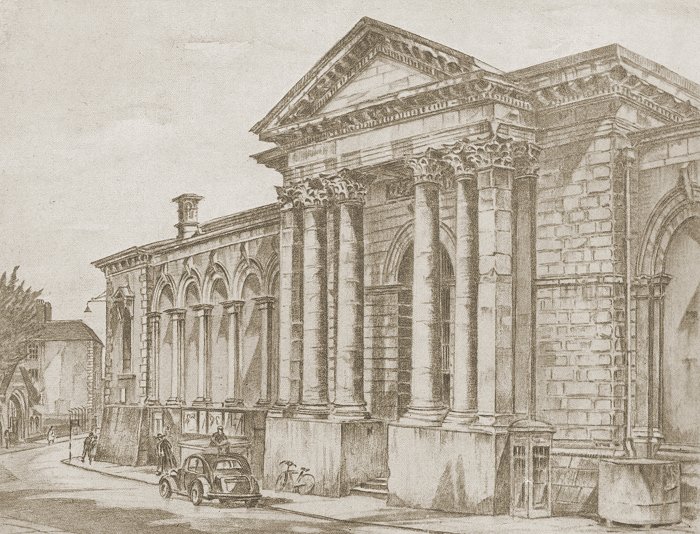
The front entrance in North
Street. From 'Century of the Opening of the Retail
Market Hall'. |
|
The original estimate for the building
work was soon exceeded. In July 1852 a further agreement was
reached between the Council and the Market Proprietors
because by that time £21,760 had been spent on the building,
which didn’t include internal fittings and market stalls. In
November, 1852 the Council purchased a fountain which would
be an important feature in the centre of the building. The
fountain, which cost £150 was called ‘Swan with boy’. It had
been made by the Coalbrookdale Company for display at the
Great Exhibition in 1851. The Council also purchased a basin
for the fountain at an additional cost of £85. |
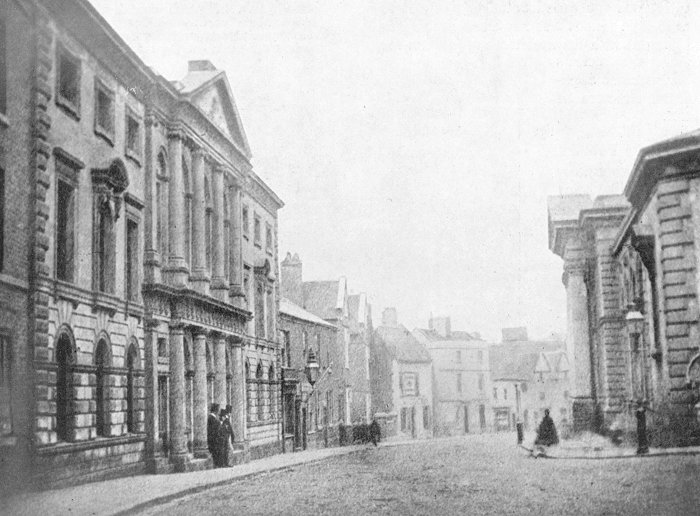
A view of North Street with the
old Town Hall on the left and the Retail Market on the
right. The old Town Hall had formerly been the Lion
Hotel. It survived until the building of the later Town
Hall in the late 1860s. From 'Century of the Opening of
the Retail Market Hall'. |

The old retail market drinking
fountain, seen at Wightwick Manor in 2009. |
The plans for the building included an
ornamental clock tower which was to be erected at the
Exchange Street end of the site.
When the tower had been built it was
discovered that the lower portion of the building was not
strong enough to support the tower. So the tower had to be
taken down at a cost of £200.
The final cost for the building was
£29,000.
The Coalbrookdale fountain stood in the
market for 25 years, by which time it was in a dilapidated
state and became the regular meeting place of a number of
undesirables.
It was removed and became a feature in
West Park which opened in 1881. |
|
The
following description of the new market hall
appeared in the Wolverhampton Chronicle on
Wednesday 9th March, 1853:
The new Market Hall
The opening of this
handsome structure (which we have already
described) for its intended purposes, took
place, unmarked however by any ceremony, on
Wednesday last. At a comparatively early hour
those who had engaged shops or standings
exhibited their commodities, but the day proved
cold and stormy, snow and rain fell abundantly
and the visitants, consequently, were many less
than expected.
The leading approach to the
hall, also that by Exchange Street, was in such
an unfinished state and so intolerably muddy
that it might be almost conjectured that the
spot was designedly left in its rough and dirty
condition as an obstruction to visitors to the
market. In several places the mud was more than
ankle deep. The transactions of the day
therefore, were of a very limited character, and
sinister predictions were frequently heard.
On Saturday, however,
although on that day advantage of favourable
weather was not fully experienced, the whole
space of the market under the arcades was
crowded and a reasonable share of business
seemed to be transacted. The charge for first
class shops beneath the arcades ranges from 9s
to 15s per week; their present number is 104, of
which no less than 86 were taken before the
opening of the market; there will however be an
extra charge for gas. In the open space forming
the centre of the market, the charge for
standing is 4d per foot which entitles the party
paying the amount to occupy the space the whole
of the week. Temporary stalls occupy portions of
the market on the north and south sides for
which the charge is 6d per foot per week.
The whole area of the
market is about 6,000 square yards, of which
considerably more than half (the extreme portion
of the quadrangle) is covered forming an arcade,
and likewise a range of stalls open towards the
centre of the market. |
|
|
The Wolverhampton Improvement Act of
1853 allowed the Council to acquire the market hall under
the terms of the 1852 agreement, after the execution of a
Deed of Transfer.
This was completed in February 1859
when the ownership of the building was transferred to the
Council at a cost of £28,492.7s.0d.
By 1868 the market had gained the
reputation ‘of being the worst conducted market hall in
England’.
A number of stall holders
complained to the Markets Committee about the lack of
enforcement of local bye laws, pick-pocketing was rife, and
so the Inspector of Markets was instructed by the Committee
to ensure that the police in attendance would summons any
party who persisted in breaking the by laws. |
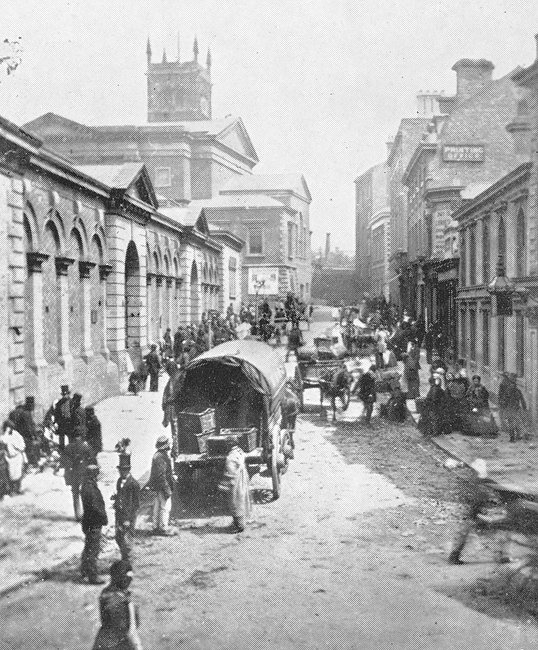
Looking up Cheapside in the 1880s or
1890s with the southern side of the Retail Market Hall on
the left. From 'Century of the Opening of the Retail Market
Hall'. |
|
In July 1869 the Markets
Committee took over the running of the market
hall. In November 1871 the Committee reported:
The comfort and convenience
of the frequenters of the market hall have been
improved by the temporary employment of
policemen who have exerted themselves in ridding
the place of unruly boys and others who attended
the hall for no other purpose than loitering.
The bye law against smoking has been strictly
enforced. |
|
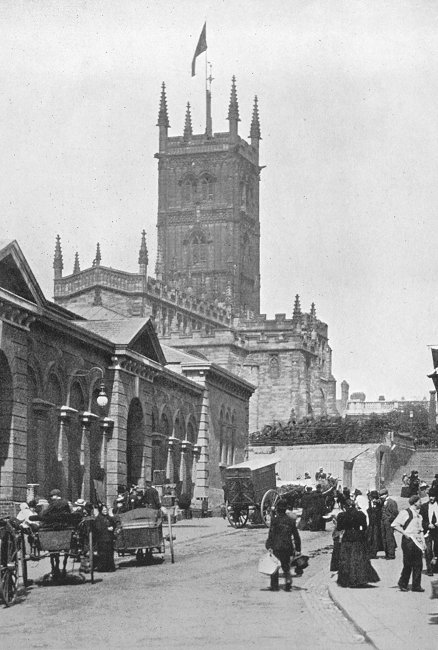
A view of Cheapside and the Market
Hall from between 1898 and 1902. From 'A Souvenir of
Wolverhampton'. |
In 1872 a special agreement was made
between each stall holder and the Council, relieving the
Council of any liability for damage caused by rain water
penetrating the roof.
In the 1880s two contracts were entered
into for keeping the roof in repair for terms of five years.
Considerable reconstruction of the roof
and extensive re-glazing was carried out in the 1890s, in
1937, and in 1941.
The internal layout was altered in 1873
and 1874 when stalls were moved to provide two new walkways
to allow better access to some of the stalls.
New fish stalls opened in 1890 and 1891
and electric lighting was introduced in 1895 at a cost of
£753. |
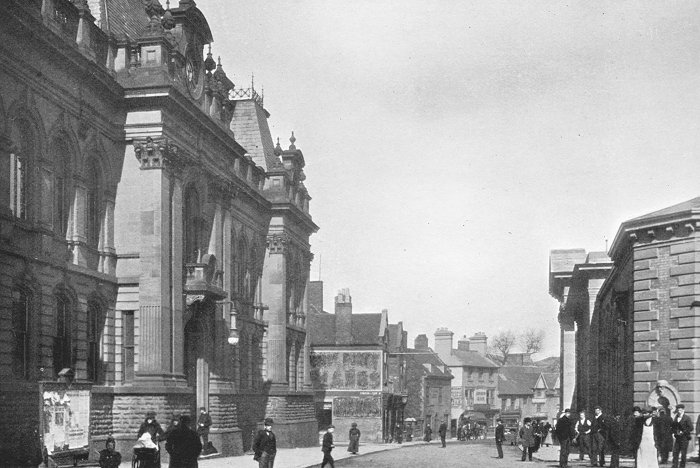
Looking up North Street in about
1900 with the Market Hall on the right and the Town Hall
on the left. From 'A Souvenir of Wolverhampton'. |
|
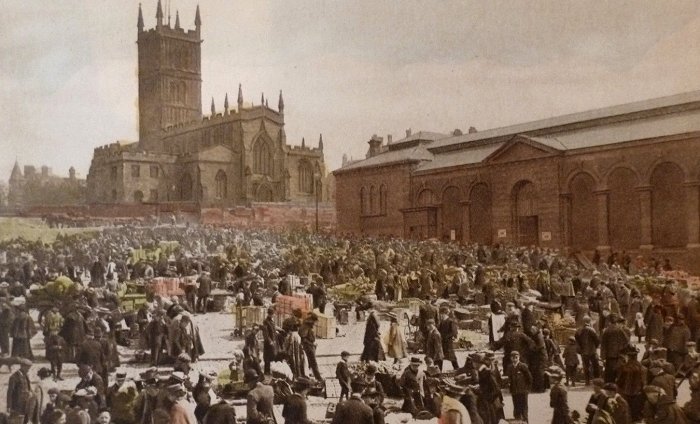
The old Market Patch with the
Market Hall on the right. From an old postcard. |
|
Later Years
In the latter years of the nineteenth
century plans were made to improve the market facilities by
the introduction of a cold store. It was initially planned
to be in the market hall basement, but finally was
incorporated into the new wholesale market. In 1901 the
building was renovated and the stalls were classified and
graded into divisions suitable for different trades, which
greatly helped the visiting public to quickly find what they
were looking for. |
|

The opening days and times in
1908. From the 1908 Wolverhampton Red Book. |

The Market Hall refreshment rooms
in about 1900. The lady in the black dress is the
manageress, Mrs. F. T. Hinds. Dinners were available for
4, 5, 6, and 7 pence. From 'Century of the Opening of
the Retail Market Hall'. |
| The market went from strength to strength. In 1896 the
stall holders’ rent amounted to £3,156, which had increased
to £4,749 in 1905. This exceeded £5,000 in 1922, in 1939 it
had risen to £7,000, and in 1953 it totalled £13,018. |
|

The Market Hall in 1953. From
'Century of the Opening of the Retail Market Hall'. |
|

From 'Century of the Opening of
the Retail Market Hall'. |
|
As early as 1944 the Council’s
Reconstruction Committee, which considered the post war
development in the centre of Wolverhampton, expressed the
view that the existing market hall had passed its useful
structural life, and its retention would involve
extensive and costly repairs, necessitating its closure
for a considerable time.
The Council agreed with the
Committee’s findings and in July 1953 a model of the new
market hall was made in the Borough Engineer’s
Department. The original building continued in use until
May 1960 when it closed for the last time. The
market then moved to the new building in Salop Street,
which was officially opened by Lord Morrison of Lambeth,
on 22nd June, 1960. Unlike its predecessor it had a
relatively short life of only 56 years. |
|

The model of the planned retail market in Salop Street.
From 'Century of the Opening of the Retail Market Hall'. |
|

Another view of the model. From
'Century of the Opening of the Retail Market Hall'. |
|
References:
The Story of the Municipal Life of
Wolverhampton by William Highfield Jones, J.P. Published in
1903 by Alexander & Shepheard Limited, London.
Centenary of the Opening of the Retail
Market Hall 1853 - 1953. Published by Wolverhampton Council
in 1953.
A History of Wolverhampton by Chris
Upton. Published in 1998 by Phillimore & Company Limited,
Chichester.
A Souvenir of Wolverhampton published
by Alftred Barker of Wolverhampton in 1902. |
 |
Return to
the
previous page |
|